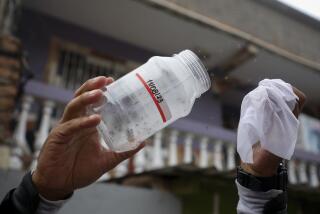Zika’s coming, and there’s not enough money for another health emergency

Less than two years after the Ebola epidemic set off a scramble for money to contain that deadly virus, state and local health officials around the country are rushing to prepare for Zika outbreaks this spring and summer.
But after years of declining funds, many are coming up short.
Government investment in public health has been declining for years. So too has the nation’s public health workforce, which is almost 20% smaller than it was in 2008, according to health authorities.
Now, with the second threat of a major disease outbreak in three years, America’s public health agencies – and the federal Centers for Disease Control and Prevention – are again begging for aid.
“It’s no way to respond to an emergency,” said Jeffrey Levi, an public health expert at George Washington University and former head of the nonprofit Trust for America’s Health.
Last month, CDC officials warned that Zika outbreaks could be expected this summer across much of the United States from Central and Southern California to as far north and east as New Jersey. In Puerto Rico, where hundreds of cases have been reported, “hundreds of thousands” could end up infected, agency officials said.
The disease is spread primarily by mosquitoes, although it can also be transmitted sexually, according to health officials. Many people who contract the virus will not get sick, but the virus is more dangerous to pregnant women as it has been linked to brain abnormalities in newborns, including a small head, known as microcephaly.
Congressional Republicans have so far rejected requests from President Obama for $1.9 billion in new money for Zika, arguing that the administration should use funds that were appropriated to fight Ebola.
Last month, the administration began shifting about $600 million in Ebola funding. But federal health officials and public health experts warn that this strategy risks leaving holes in the nation’s emergency preparedness and undermining global efforts to prevent future epidemics.
Among other problems, Ebola remains active in parts of West Africa and thus still threatens the rest of the world.
Closer to home, state and local public health offices are juggling numerous other tasks. These include containing existing infectious diseases such as measles and tuberculosis; preparing for tropical illnesses such as dengue fever that may become a larger threat as the climate warms; and supporting prevention efforts aimed at tobacco and chronic diseases such as diabetes, which many experts see as the nation’s biggest health threats.
“We just can’t keep robbing Peter to pay Paul,” CDC Director Dr. Thomas Frieden told journalists in Boston last week, noting the country must be better prepared to deal with health emergencies without raiding existing programs.
Unlike agencies that respond to earthquakes or floods, Frieden said, the CDC can stop disasters from occurring if public health officials can prevent a disease outbreak from becoming an epidemic.
“You can make the earthquake not happen,” he said.
That is becoming more difficult as resources dwindle, according to public health officials across the country.
Between 2005 and 2013, the CDC’s inflation-adjusted budget declined from $7.07 billion to $5.98 billion, according to an analysis by the Trust for America’s Health.
State and local funding for public health efforts have also been falling.
That has dramatically cut into the nation’s public health agencies, which have eliminated more than 51,000 positions since 2008, according to a report by the National Assn. of County and City Health Officials.
The same report found many local health departments have been cutting clinical services, such as immunization and diabetes and blood pressure screenings – though other services have been added in some places.
The reductions parallel broader cuts in government spending in recent years that have eroded federal investments in transportation, scientific research and other services.
See the most-read stories this hour >>
So-called nondefense discretionary spending – the budget category that excludes spending on the Pentagon and major healthcare and retirement programs such as Medicare and Social Security – is projected to reach its lowest level relative to the economy since 1962, according to an analysis by the Center on Budget and Policy Priorities, a left-leaning Washington think tank.
Chronic underfunding for public health has forced Congress to repeatedly pass emergency measures in the face of crises, as lawmakers did in 2014 to respond to Ebola and in 2005 and 2006 to respond to a pandemic flu outbreak.
This form of crisis funding slows public health responses to disease outbreaks as agencies often must hire staff, train volunteers and take other steps to ramp up, said James Blumenstock, who oversees health security programs for the Assn. of State and Territorial Health Officials.
“We are much better off if we maintain a public health system that has a higher state of preparedness,” he said.
The unpredictable funding has left local officials from Los Angeles to Houston to Baltimore scrambling to plug holes in their budgets and shelve vital initiatives.
In Los Angeles County, the nation’s largest local government, the public health department has been stretching to prepare for Zika and deal with two major environmental disasters, including the Porter Ranch gas leak and the potential contamination of as many 10,000 homes from the former Exide Technologies battery recycling plant.
At the same time, the county is losing more than $1.5 million of federal emergency aid from the CDC as the federal agency redirects money for the Zika response.
To respond, the county will cut, among other things, planning for natural disasters, including programs to train volunteers and prepare community leaders in case government services are unavailable, as they were in New Orleans after Hurricane Katrina.
“People may not appreciate this, but in a devastating earthquake, the government may not be there,” said Cynthia Harding, the county’s interim public health director. “We need to prepare for that.”
Around Houston, stretched public health authorities are planning a public information campaign. But local health clinics serving low-income patients plan to distribute their own Zika preparedness kits, including condoms and insect repellent, in part because the government response has been slow, said Katy Caldwell, executive director of Legacy Community Health, a large network of health centers.
“It feels like we are not getting ahead of this,” said Caldwell, whose clinics along the Gulf Coast serve about 100,000 patients, including many immigrants from Latin America. Last month, Legacy reported its first patient with Zika, a pregnant woman from El Salvador.
“We as a community are not doing the preventive things that need to happen,” Caldwell warned.
Staff writer Soumya Karlamangla contributed to this report.
ALSO
10 ways to keep yourself safe from Zika, now definitively linked to birth defects
Editorial: Zika will only get ‘scarier’ if lawmakers are stingy with emergency funds
Hope Solo, others express concerns over Zika virus at Summer Olympics in Rio de Janeiro
Twitter: @noamlevey
More to Read
Start your day right
Sign up for Essential California for news, features and recommendations from the L.A. Times and beyond in your inbox six days a week.
You may occasionally receive promotional content from the Los Angeles Times.







